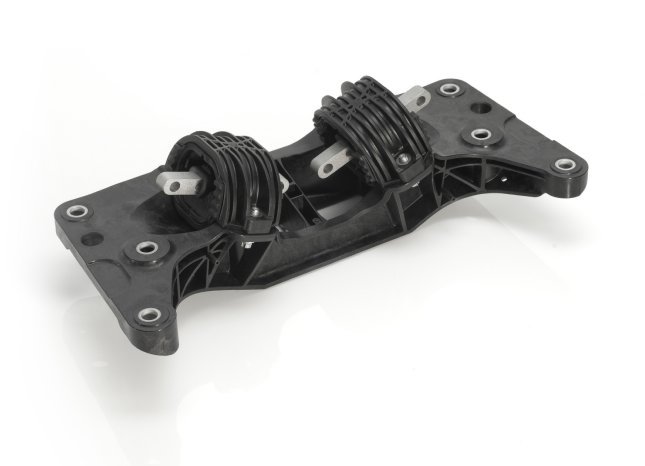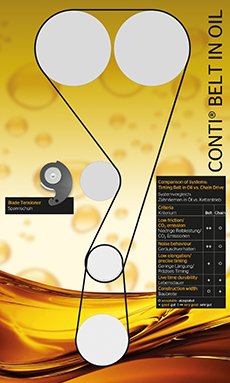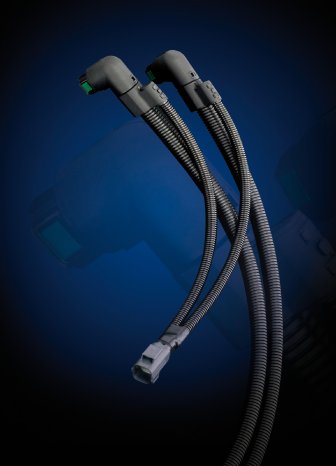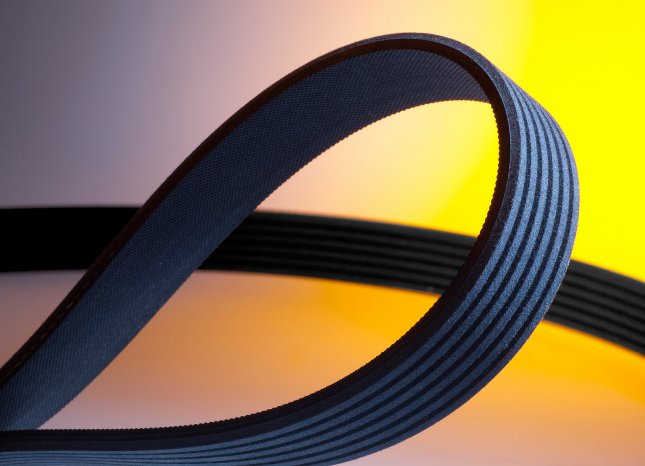Lighter materials and energy-efficient components play an important role in green mobility. To save weight, ContiTech ever more frequently uses polyamide to make even ultra heavy-duty motor mounts and structural components. These components shave fifty percent off the weight of comparable conventional aluminum engine mounts. Interior foils for door trim and instrument panels made from TPO (olefin-based thermoplastic elastomers) are not only recyclable and halogen-free. They also reduce the weight by between 25 and 50 percent, depending on the design.
Drive belts offer another lever for promoting low-consumption and emission-reduced engines. These generate less friction and provide longer service life than conventional drive belts. Heavy-duty multiple V-ribbed belts from ContiTech are also at work in fuel-efficient, CO2-reducing start-stop systems. At the same time, special hose lines make for more effective air conditioners and exhaust gas cleaning systems in an increasing number of cars.
Health and environmental considerations are closely linked, as demonstrated by ContiTech's current range of surface materials. Ultra-modern materials for seat covers and door trim are particularly kind to the skin, free of contact allergens, and low in emissions. They can contain up to fifty percent renewable raw materials and exhibit a CO2 balance that is fifteen percent than standard cover materials. In view of the fact that all of us spend up to two-and-a-half years of our life in a car, it is important to make the interior climate as healthy as possible. In China, the Government has specified guide values for pollutant evaporation in the vehicle interior; these materials make it easier to comply with these values.
Acella® Eco natural: Seat Material Made from Renewable Raw Materials
With the Acella® Eco product family, the ContiTech surface specialist Benecke-Kaliko is contributing in a major way to improving the climate in vehicle interiors. As an interior material for vehicle seats and door trim, Acella® Eco green is is ultra-skin-friendly, free of contact allergens, and low in emissions. Acella® Eco natural has a renewable raw material content of up to fifty percent and exhibits a fifteen percent better CO2 balance than standard cover materials. TEPEO® interior foils are up to fifty percent lighter than the usual PVC products. This can help save up to two kilograms of weight in the car. But it is not just inside the vehicle that these surface materials are kind to people and the environment. They offer benefits already in the manufacturing stage and then again later during recycling. The eco balance testifies to this. The entire life cycle of TEPEO® was compared with that of a conventional PVC foil: The lightweight TEPEO® foil has a forty-eight-percent better CO2 balance than the standard foil.
Benecke-Kaliko addresses the demand for high-quality yet resistant materials with two innovative products. In addition to the already familiar DecoJect(TM) thin foil, this development makes use of the TEPEO® Protect and TEPEO 2® Protect surface material, which is highly resistant to scratches. It can be used anywhere that scratches could typically ruin the visual effect: On the instrument panel, the center console, the storage compartment, or door and interior trims. Not only are the foils scratch-resistant, though, thanks to a specially developed polymer material. They are also sealed with an extremely friction-resistant polyurethane varnish. This prevents damage caused by frequent cleaning with appropriate cleaning agents.
Plastic Replacing Aluminum - Engine Mounts and Structural Components Getting Lighter
Use plastic rather than metal for components is another way to cut weight and render vehicles more eco-friendly. ContiTech's glass-fiber-reinforced polyamide engine mounts and structural components are at work in vehicles from General Motors, BMW, and Porsche. These ultra-strong components save fifty percent off the weight of a comparable conventional aluminum engine mount. What is more, plastic can be molded at lower temperatures than, for example, aluminum, so much less energy is required for the production process. It can also be recycled in lots of different ways.
High-performance Hoses Ensure Ecological Efficiency
To render combustion more effective and thereby reduce exhaust gases, engineers are developing the next generation of highly turbocharged engines. These work at pressures above three bar and thus require special hoses. The new materials and innovative combinations of different knitted fabric and rubber materials used here easily outperform conventional materials. ContiTech has likewise taken on a vanguard role in the case of components used to purify exhaust gases by means of selective catalytic reduction (SCR) technology. A heatable EPDM-based (ethylene-propylene-diene rubber) hose line module ensures that the urea required for the process does not freeze. ContiTech is now also offering this cutting-edge technology for more powerfully engined cars. Comprised of air conditioning lines and an inner heat exchange unit, the re-designed range of ECO AC products ups the efficiency of air conditioning units, reduces weight, and lowers the level of refrigerant usage.
Drive Belts for Low-Emission Engines
The drive belt used is another factor influencing how fuel-efficient and clean an engine is. A highly flexible multiple-V-ribbed belt, the CONTI® UNIPOWER ECO2-FLEX, reduces the power loss in auxiliary unit drives by ten percent. High-performance multiple V-ribbed belts from ContiTech can also be found in fuel-efficient, CO2-reducing start-stop systems. The latest development at ContiTech Power Transmission Group is the timing belt in oil: It can be made narrower than the model which runs in the dry and is even quieter as the oil not only reduces friction but also damps the belt. This is important because the downsized engines, for which there is ever greater demand, also run less smoothly by their very nature. Another example is the belt-driven starter generator with special high-performance V-ribbed belt. In start-stop operation, it lowers fuel consumption by as much as five to ten percent, thereby cutting emissions at traffic lights or in stop-and-go rush-hour traffic.







